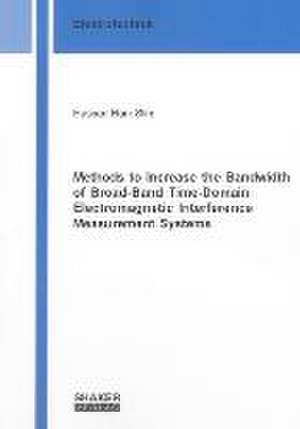Methods to Increase the Bandwidth of Broad-Band Time-Domain Electromagnetic Interference Measurement Systems: Berichte aus der Elektrotechnik
Autor Hassan Hani Slimen Limba Engleză Paperback – 11 feb 2014
Din seria Berichte aus der Elektrotechnik
-
 Preț: 94.09 lei
Preț: 94.09 lei -
 Preț: 271.67 lei
Preț: 271.67 lei -
 Preț: 264.64 lei
Preț: 264.64 lei -
 Preț: 244.42 lei
Preț: 244.42 lei -
 Preț: 266.75 lei
Preț: 266.75 lei -
 Preț: 288.74 lei
Preț: 288.74 lei -
 Preț: 242.38 lei
Preț: 242.38 lei -
 Preț: 112.77 lei
Preț: 112.77 lei -
 Preț: 260.95 lei
Preț: 260.95 lei -
 Preț: 261.83 lei
Preț: 261.83 lei -
 Preț: 286.01 lei
Preț: 286.01 lei -
 Preț: 259.51 lei
Preț: 259.51 lei -
 Preț: 272.11 lei
Preț: 272.11 lei -
 Preț: 262.47 lei
Preț: 262.47 lei -
 Preț: 265.26 lei
Preț: 265.26 lei -
 Preț: 264.44 lei
Preț: 264.44 lei -
 Preț: 264.97 lei
Preț: 264.97 lei -
 Preț: 292.99 lei
Preț: 292.99 lei -
 Preț: 262.47 lei
Preț: 262.47 lei -
 Preț: 298.00 lei
Preț: 298.00 lei -
 Preț: 294.70 lei
Preț: 294.70 lei -
 Preț: 176.99 lei
Preț: 176.99 lei -
 Preț: 268.88 lei
Preț: 268.88 lei -
 Preț: 272.19 lei
Preț: 272.19 lei -
 Preț: 264.80 lei
Preț: 264.80 lei -
 Preț: 264.14 lei
Preț: 264.14 lei -
 Preț: 257.81 lei
Preț: 257.81 lei -
 Preț: 265.04 lei
Preț: 265.04 lei -
 Preț: 278.85 lei
Preț: 278.85 lei -
 Preț: 261.91 lei
Preț: 261.91 lei -
 Preț: 261.17 lei
Preț: 261.17 lei -
 Preț: 261.24 lei
Preț: 261.24 lei -
 Preț: 244.64 lei
Preț: 244.64 lei -
 Preț: 277.53 lei
Preț: 277.53 lei -
 Preț: 278.62 lei
Preț: 278.62 lei -
 Preț: 264.00 lei
Preț: 264.00 lei -
 Preț: 92.74 lei
Preț: 92.74 lei -
 Preț: 259.90 lei
Preț: 259.90 lei -
 Preț: 322.09 lei
Preț: 322.09 lei -
 Preț: 245.06 lei
Preț: 245.06 lei -
 Preț: 282.73 lei
Preț: 282.73 lei -
 Preț: 245.06 lei
Preț: 245.06 lei -
 Preț: 278.82 lei
Preț: 278.82 lei -
 Preț: 100.30 lei
Preț: 100.30 lei -
 Preț: 264.59 lei
Preț: 264.59 lei -
 Preț: 281.64 lei
Preț: 281.64 lei -
 Preț: 279.71 lei
Preț: 279.71 lei -
 Preț: 241.72 lei
Preț: 241.72 lei -
 Preț: 281.87 lei
Preț: 281.87 lei
Preț: 257.33 lei
Nou
Puncte Express: 386
Preț estimativ în valută:
49.24€ • 50.80$ • 41.09£
49.24€ • 50.80$ • 41.09£
Carte indisponibilă temporar
Doresc să fiu notificat când acest titlu va fi disponibil:
Se trimite...
Preluare comenzi: 021 569.72.76
Specificații
ISBN-13: 9783844025569
ISBN-10: 3844025561
Pagini: 107
Ilustrații: 6 farbige Abbildungen
Dimensiuni: 149 x 211 x 14 mm
Greutate: 0.16 kg
Editura: Shaker Verlag
Seria Berichte aus der Elektrotechnik
ISBN-10: 3844025561
Pagini: 107
Ilustrații: 6 farbige Abbildungen
Dimensiuni: 149 x 211 x 14 mm
Greutate: 0.16 kg
Editura: Shaker Verlag
Seria Berichte aus der Elektrotechnik
